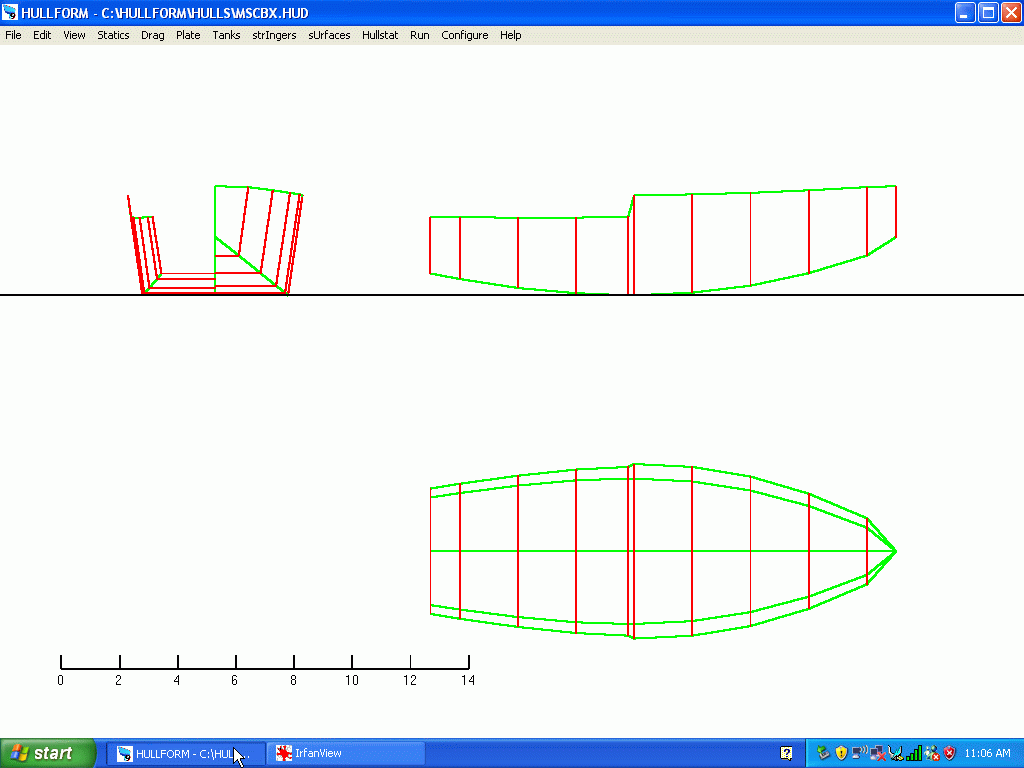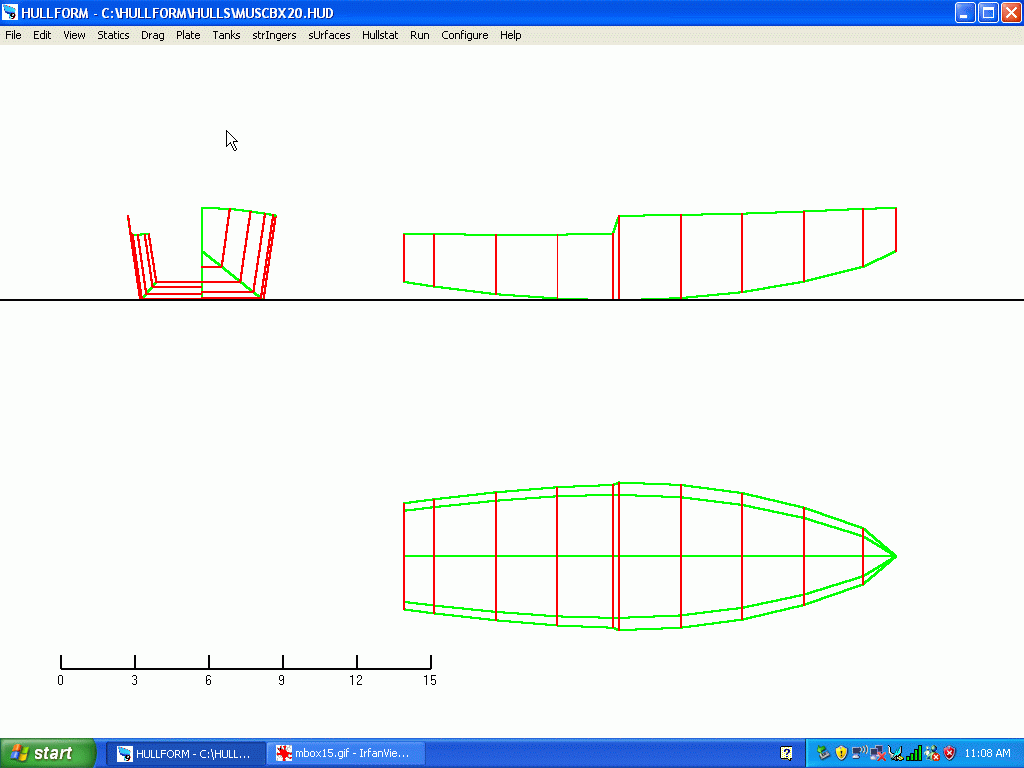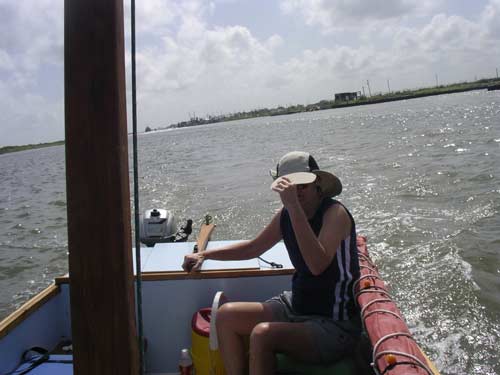LET US GO BACK...
... two decades to when all we had was a pencil and a paper. The
problem to be solved for the still young designer was howinhell to
calculate the stablity of a boat, especially in roll, such that a
fellow might think then about how much sail a boat might carry and
also how much ballast a boat might need to be self rightious. No
computers allowed back then.
Then we might fast forward to last year when the much older designer,
giving a talk in front of some big time boat nuts, says off the cuff
that he didn't think a boat's length had anything to do with
stability besides making a boat heavier. Then he peeked at the faces
in the group to see if he had maybe said something stupid to which
there would be objections. None came forth although the looks were
somewhat worried.
I probably admitted that I had never really done any analysis to back
up the statement and now is a good time to do that. So the question
is...
DOES A BOAT'S LENGTH HAVE ANYTHING TO DO WITH ITS ROLL STABILITY???
...anyway, back to the early pencil and paper. Starting with basics I
imagined a square stick sitting on its side like this...

If you start to "roll" it it will start to lift up on one edge. The
"righting moment" at the start will be the weight times half the
width of the stick. Then as you start to roll it the "moment" arm
between the support corner and the center of gravity gets shorter to
the point where, at 45 degrees of roll, it goes to zero. Beyond that
point the stick will try to flop the other way over, it "capsizes".
Well, its sort of like a catamaran, isn't it, since the cat will have
its support point all on the corner once it starts flying a hull. And
by this time I already knew that the classic sharpie hull, in this
case my old Bolger Jinni, would capsize at very close to 45 degrees
of roll (I was way to busy to measure the exact angle at those
times). And then I read that Howard Chapelle considered "self
righting" for a sharpie hull to be the ability to recover from a 45
degree heel. Right away I felt I was on to something. But note,,,the
length of the rolling stick has nothing to do with the results.
IN REAL LIFE....
...a monohull doesn't roll around its outer chine like the stick
does. Instead it "mooshes" (a technical term I don't have the time to
explain now) down until the weight of the entire boat is countered by
the weight of the water displaced by the abovementioned mooshing, so
its righting arm will be less than the above simple example. Like
this...

(...and keep in mind that the center of gravity of the real boat
isn't going to be at the middle of the "square' - it could be about
anywhere given the ballast, rig, crew, etc, but the designer can
calculate it and control it to some degree).
It is possible to do the analysis of the above with pencil and paper
for a given cross section in the old fashioned way. But you will need
to redraw and calculate the "righting arm", the horizontal distance
between the weight center and the supporting displaced water, at each
angle of heel to get a handle on it. Still it can be done, and I did
it.
BUT, YOU SAY,...
...a real boat is usually a shape that varies in cross section all
along its length. Calculating the righting arm at just one section
(hint - use the maximum beam section) doesn't account for the normal
tapering of the ends of the hull. To use just one section is to think
in two dimensions when the real hull has three. Well, it is possible
to do the analysis shown above in three dimensions. First you will
draw the heeled waterline on the end view of the hull sections and
determine the heeled view at various sections along the length, do
the righting analysis at each section and then integrate it all
together to get a realistic answer. A lot of work. In one of
Chapelle's books he talks about doing this in the old days with a
wonderful old gadget called a planimeter that figures out areas
mechanically, and so forth. I got the impression the work was so
tedious it was seldom done, except maybe for large ships and even
then maybe only for a few roll angles and only after the real boat
had sunk and the lawyers were trying to pin the blame.
But I plugged away at it with a simple sharpie shape. I think I got
it right, but....
GUESS WHAT???...
....it was clear afterward that the great lion's share of the roll
stability of a real boat is in its center area, where the beam is
maximum. If you did the analysis there alone you would get the right
answer probably to within 90 percent. So I still thought that the
boat's length had almost nothing to do with its roll stability
(besides affecting the hull weight). The roll stability is
essentially a factor of the boat's beam and cross sectional shape and
the weight and cg issues.
It's deceptive because the roll stability really determines how much
sail you can hoist. I think almost anyone who takes a WAG at how much
sail his hull can hoist will take a side view of his boat and start
drawing in sails to fit. And yet what I was seeing is that the side
view had nothing to do with it. Look at the maximim cross section of
the boat to figure the sail area, not the length. The length has
nothing to do with it.
...OR DOES IT???...
...enter the computer, about 1995 for me. A nice toy for word
processing for most of us. But even my old Apple2 was taught to
expand hull panels so folks could make instant boats without lofting.
After a while I got on the internet and found the free "Hullform"
program. I have always carried a link to that website. You can find
it somewhere below if you scroll far enough. I noticed that the link
has changed and you will be redirected to the current download
location, but it still is there.
I don't know how Hullform works but I have never found it to tell me
a lie. Even in the old days of 1 megaherz processors it would spit
out stability and displacement details as soon as you clicked
"enter". It was and still is amazing. Now, it needs to know all about
you boat of course. You need to tell it the shape by typing in
offsets at different sections along your hull. (And by the way, I
have found that the earliest versions of Hullform are easiest to use
for doing that. Later versions, like most programs, get so many fancy
options that you can eventually fail to see the forest for the
trees.) And it will want to know the weight and cg location. So it
needs to know all this important stuff just as you would for a hand
analysis, and I suppose any program that doesn't ask for such isn't
really up to the task.
So, at long last twenty years on, let's use Hullform to see if there
is any truth to my guess that the length of a hull has nothing to do
with the roll stabitily. I found in my old files my Hullform model of
Musicbox2. Here is the program's graphic of that old file...

Then I stretched the basic design simply by respacing the sections so
that the initial 15' design became a 20' design - the beam stayed the
same. Like this...

Then I let Hullform do all the work and got righting moment curves
for both designs. I did this for three examples - the first with the
15' hull at 1600 pounds total...

... and then for the 20' hull also at 1600 pounds...
 and then for the 20' hull at 2000 pounds total with the idea
that the longer boat will be heavier. The vertical cg was the same in
all cases...
and then for the 20' hull at 2000 pounds total with the idea
that the longer boat will be heavier. The vertical cg was the same in
all cases...

Hullform is giving the stabiltiy solution in the form of Gz, the
righting arm. So the righting moment is Gz times the weight. Anyway,
it shows at 1600 pounds, the Gz is the same for the 15' and 20' hulls
so the length has almost no effect on stability. Note that for the
2000 pound 20' hull that the Gz actually goes down compared to the
lighter boats. I would say that is the effect of the heavier boat
mooshing deeper into the water and, when rolled, cannot be supported
as well by the chine area as the lighter boats.
No, just stretching the hull from 15' to 20' made no appreciable
change in the stability. The length just doesn't matter all by
itself.
Well, everybody knows a good scientist can use numbers to prove any
damn thing he wants.
Contents
Ladybug

LADYBUG, SAILBOAT, 14' X 5,5', 250 POUNDS EMPTY
Ladybug is a lot like Woobo which was one of my first designs.
There was a Woobo near here for a while. I never got to sail it but
was told it would really fly. (That boat was made of Lauan plywood
from Home Depot which fell to pieces after rainwater filled the
boat over the winter.) Ladybug is a bit shorter and wider and
deeper and has bench seating, much more suited for older legs. Both
boats have a small motor well. The best motor for something like
this is the 2hp Johnson/Evinrude which weighs 25 pounds. Even that
is overkill since 1hp will push this hull at top speed, anything
more just makes bigger waves. Here Sandra Leinweber pushes into a
stiff breeze with a 2hp Honda.

This shape of hull with multichines and a plumb bow seems to be a
good all around thing with rough water abilities. I think if there
is a problem it is that it has almost no lateral drag and unless
the boat has a big skeg or keelson or something like a leeboard or
daggerboard or centerboard it would just as soon go sideways as
straight. I've given Ladybug a keelson and when using power you
should keep the leeboard down just enough so its tip drags the
water.

Ladybug's hull has the layout I like the best - a 6-1/2' cockpit
between two storage/buoyancy boxes. It would be a great solo
camping boat. The buoyant wooden spars prevent it from turning
turtle. You bring it upright with weight on the lowered leeboard.
Then you must climb back on board and a slot in the rudder seems to
be the best boarding ladder around, bringing your weight back on
board where it least affects the boat. You will have to bail some
water.
I've kept the same sail as with Woobo, a 75 square foot balanced
lugsail. It hoists on a 13' mast with 11' yand and boom. All very
low tech built with common materials.
Chuck Leinweber of Duckworksmagazine.com built
the prototype and brought it to our Rend Lake messabout so I had a
chance to go for a long ride in it. One thing that impressed me was
how large it was for a 14' boat. In the opening photo you see it
sail with three men on board, all comfortably sitting to windward
on the bench seat, and I'm told it has sailed with four men with no
effort. I do think it would be quite suitable for a family of four
say with lots of room for all and storage space for all their junk.
Here Sandra Leinweber sets things up at a recent campout on the
Texas coast:

Here is the same campout from a distance with the mast folded to
support a tent. I'm told the tent is not done yet. Chuck has
modified the bench seats so that his expand towards the center and
meet in the center thus making a 6' x 5' sleeping platform. Turns
out a small commercial camping tent can be set up on that platform
and that is what they are using for now.

Ladybug uses taped seam construction. Six sheets of 1/4" plywood,
one sheet of 3/8" plywood and two sheets of 1/2' plywood.
Plans for Ladybug are $40.
Contents
Prototype News
Some of you may know that in addition to the one buck catalog
which now contains 20 "done" boats, I offer another catalog of 20
unbuilt prototypes. The buck catalog has on its last page a list
and brief description of the boats currently in the Catalog of
Prototypes. That catalog also contains some articles that I wrote
for Messing About In Boats and Boatbuilder magazines. The Catalog
of Prototypes costs $3. The both together amount to 50 pages for
$4, an offer you may have seen in Woodenboat ads. Payment must be
in US funds. The banks here won't accept anything else. (I've got
a little stash of foreign currency that I can admire but not
spend.) I'm way too small for credit cards.
I think David Hahn's Out West Picara is the winner of the Picara
race. Shown here on its first sail except there was no wind.
Hopefully more later. (Not sure if a polytarp sail is suitable
for a boat this heavy.

Here is a Musicbox2 out West.

This is Ted Arkey's Jukebox2 down in Sydney. Shown with the
"ketchooner" rig, featuring his own polytarp sails, that is shown
on the plans. Should have a sailing report soon.

And the Vole in New York is Garth Battista's of
www.breakawaybooks.com, printer of my book and Max's old outboard
book and many other fine sports books. Beautiful job! Garth is
using a small lug rig for sail, not the sharpie sprit sail shown
on the plans, so I will continue to carry the design as a
prototype boat. But he has used it extensively on his Bahamas
trip towed behind his Cormorant. Sort of like having a compact
car towed behind an RV.

And a Deansbox seen in Texas:

Another prototype Twister is well along:

And the first D'arcy Bryn is taped and bottom painted. You can
follow the builder's progress at http://moffitt1.wordpress.com/
....

Contents
AN INDEX OF PAST ISSUES
THE WAY BACK ISSUES RETURN!
MANY THANKS TO CANADIAN READER GAETAN
JETTE WHO NOT ONLY SAVED THEM FROM THE 1997 BEGINNING BUT
ALSO PUT TOGETHER AN EXCELLENT INDEX PAGE TO SORT THEM
OUT....
THE WAY BACK
ISSUES
SOME LINKS
Mother of All Boat
Links
Cheap
Pages
Duckworks
Magazine
The Boatbuilding
Community
Kilburn's Power
Skiff
Bruce Builds
Roar
Dave
Carnell
Rich builds AF2
JB Builds
AF4
JB Builds
Sportdory
Hullforms Download (archived copy)
Puddle Duck
Website
Brian builds Roar2 (archived copy)
Herb builds AF3 (archived copy)
Herb builds RB42 (archived copy)
Barry Builds
Toto
Table of
Contents



















